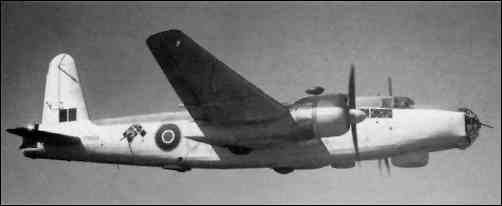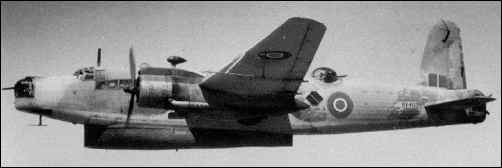Fighting the U-boats
Aircraft & Air forces
Vickers Warwick
prepared by Emmanuel Gustin

A Vickers Warwick GR Mk.V. The centimetric ASV radar under the nose,
and the retracted Leigh Light under the aft fuselage.
Among the British combat aircraft of World War II, the Vickers Warwick is one of the least known. This position in history is not undeserved, for the Warwick was obsolescent before it flew and had dangerous flying characteristics. It did make an useful contribution, however.
The Warwick was designed to meet specification B.1/35 for what was then called a twin-engined "heavy" bomber, with a span of under 100ft so that it would fit into existing hangars. It looked very much like a bigger Wellington, had a similar geodetic construction, and Vickers strived to achieve as much commonality as possible. Like the Wellington, it had gun turrets in nose and tail, and also a dorsal turret. Because of its size and weight, the Warwick needed more powerful engines than the originally planned Bristol Hercules radials. Suitable engines were the Rolls-Royce Vulture, the Napier Sabre, or the Bristol Centaurus. The first prototype, flown on 13 August 1939, had Rolls-Royce Vulture engines.
Performance and handling of the first Warwick were disappointing, although the second prototype, with Centaurus engines, was better. Because better bombers were already under development, and it was obvious that none of the three suitable engines would be available, there was little enthusiasm for the Warwick. The type was considered for production only because of its commonality of construction with the Wellington, which meant that the factories could far easier switch to the Warwick than to any other aircraft.

Vickers Warwick ASR MK.I Stage C
It carries the Mk.II lifeboat.
Also note the antennas of ASV Mk.II under wing and nose.
By the end of July 1940, work was underway to install American 1850hp Pratt & Whitney R-2800-S1A4-G Double Wasp engines, and on 3 January 1941 Vickers finally received a production contract. But production was delayed by the need for large numbers of Wellingtons, and the first production Warwick B Mk.I bomber flew only in April 1942. The flight tests revealed that the Warwick had serious handling problems, with directional instability being the most serious problem. It came as no surprise when, on 21 January 1943, it was finally decided that the Warwick would not enter service as a bomber. Of the original 250 Warwick ordered, 219 went to Coastal Command. Another 14 were converted to transports for BOAC, which soon handed them back to the RAF. Later a hundred more new-built C Mk.III transports were ordered for the RAF.

Vickers Warwick ASR MK.I Stage C
Same fitting as above.
Coastal Command urgently needed an aircraft for the Air/Sea Rescue Service, capable of carrying not only the Lindholme rescue gear, but also a lifeboat. The Airborne Lifeboat Mk.I, produced by Uffa Fox, which weighed 771kg, was 6.1m long, and could be dropped on three parachutes. The Lindholme gear included a dinghy, and several containers with food, water, and survival equipment. In July 1943, after completion of trials, the Warwick ASR Mk.I was accepted. In its fully-developed Stage C version it was equipped with ASV radar and additional fuel tanks. It could also carry the 9.1m long, 1633kg heavy Mk.II lifeboat, which could carry ten men. The ASR Warwicks retained their three gun turrets. After the 219 of the original contract, 56 more were ordered, plus 95 which had R-2800-47 engines and were sometimes described as ASR Mk.VIs. The Warwick ASR Mk.I contributed very much to the Air/Sea Rescue service, and served with fourteen squadrons. However, in warm climates the fabric skinning degraded rapidly, and the result was a shortage of aircraft.
Finally, enough Bristol Centaurus engines became available that some could be spared for the Warwick. The additional power of these engines revived the Warwick as a combat aircraft, but the modifications also created a very dangerous rudder overbalance problem, which at one time resulted in the grounding of all aircraft. The result was the Warwick GR Mk.II torpedo-bomber, with ASV radar under the nose, a nose without gun turret but with one .50 Browing machinegun, and capable of carrying three 18-in or two 24-in torpedoes, or 5557kg of bombs. 132 were built, but they were little used, most being sent to operational training units, and some to the ASR units.
The final Warwick was the GR Mk.V, which was equipped with a Leigh light, in a retractable ventral installation, for anti-submarine patrols. It lacked the dorsal gun turret. Modifications to the rudder and the addition of a dorsal fin cured the rudder overbalance problem, but reduced control authority, so that the minimum speed for single-engined flight became unacceptably high. The new fin was also added to older Warwicks. A total of 210 GR Mk.Vs were built, powered by the Centaurus VII. But when the war ended, just one squadron was equipped with them, No 179. After the war the Lancaster became available to Coastal Command, and the Warwick was rapidly retired.
Vickers Warwick GR Mk.V
Two 2500hp (1870kW) Bristol Centaurus VII 18-cylinder two-row radial
engines, driving four-bladed Rotol propellers.
Wing span 29.46m, length 22.25m, height 5.64m, wing area 94.67m2.
Empty weight 16057kg, max take-off weight 19505kg.
Max speed 480km/h at 1067m; service ceiling 5790m, range 4908km with a
6183kg load.
Armament one .50 Browning gun in the nose, two in beam positions, and
four .303 guns in the tail turret. 2776kg of bombs, or 3955kg of mines.


